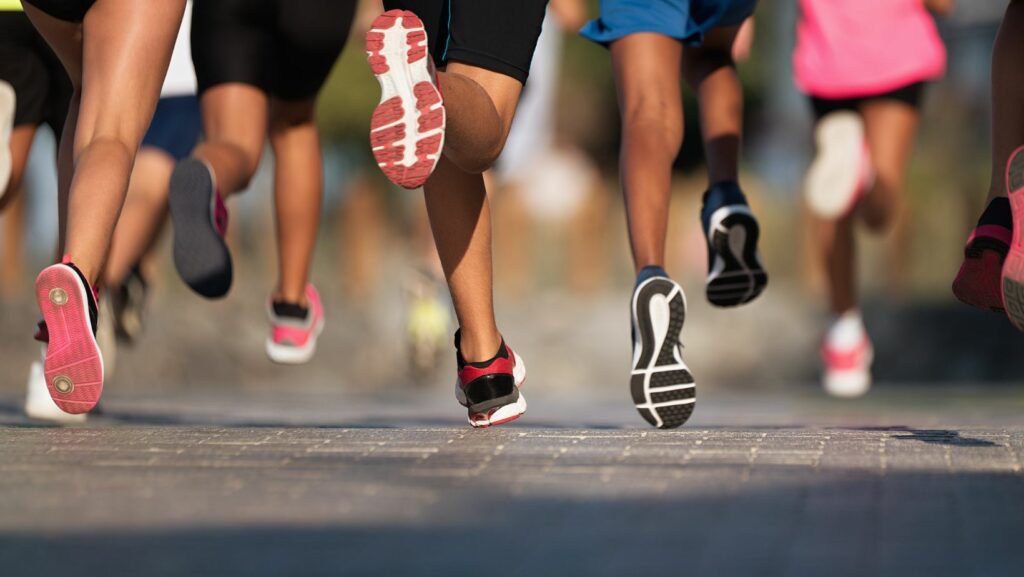Imagine trading in your couch for a pair of running shoes and a whole new outlook on life. Running transformation isn’t just about shedding pounds; it’s about shedding excuses and embracing a healthier, happier version of oneself. Whether you’re a seasoned marathoner or someone who thinks a 5K is a long-distance relationship, this journey can redefine your limits and boost your confidence.
Running Transformation
Running transformation refers to significant changes that occur through consistent running practices. It encompasses physical improvements, such as increased stamina, weight loss, and muscle development. Beyond physicality, it also involves a mental shift, fostering resilience and discipline.
Individuals often experience profound lifestyle changes. For many, running becomes a daily ritual, fostering accountability and commitment to health. Participants in this transformation journey often find themselves more motivated to pursue fitness goals and maintain a balanced diet.

The impact typically extends to social life. Many runners develop connections through running clubs or events, enhancing motivation and support. Such interactions contribute to a sense of community, promoting emotional well-being.
Health benefits frequently arise from running transformation. Studies indicate regular running lowers the risk of chronic diseases, improves cardiovascular health, and enhances overall fitness levels. Individuals who embrace running often report decreased stress levels and improved mood.
Each person’s experience with running transformation varies. Beginners may focus on establishing a routine, while seasoned runners might pursue specific performance goals. Regardless of the starting point, the outcome tends to be a richer, more fulfilling life.
Adopting running as a lifestyle choice often leads to a more positive outlook. Enthusiastic participants develop gratitude for their progress and capabilities. Ultimately, running transformation instills confidence, forging resilient individuals ready to tackle various life challenges.
Benefits Of Running Transformation
Running transformation brings numerous advantages that extend beyond the physical realm, promoting overall health and wellness. Complete commitment to a regular running routine yields significant results.
Improved Physical Health
Increased cardiovascular fitness stands as a primary benefit. Running boosts heart health, lowering blood pressure while enhancing circulation. Weight management becomes more manageable with consistent running, as it burns significant calories. Muscles grow stronger with each mile, leading to improved endurance and flexibility. Furthermore, regular running helps regulate blood sugar levels, reducing the risk of diabetes. Engaging in this activity lowers the likelihood of common health issues, including obesity and certain cancers, contributing to a healthier lifestyle overall.
Enhanced Mental Wellbeing
Positive impacts on mental health shine through running transformation. Many individuals report decreased stress levels after a jog; this occurs because running releases endorphins, often referred to as the body’s natural mood lifters. The act of running supports improved sleep patterns, allowing for better overall rest. Additionally, runners frequently experience heightened self-esteem and body image, fueling confidence. Establishing a running routine nurtures resilience, helping individuals tackle daily challenges with a renewed mindset. Ultimately, running infuses a sense of achievement and enhances mental clarity, offering tangible benefits not just for the body, but also for the mind.
Key Elements Of Running Transformation
Running transformation involves several key elements that facilitate growth and improvement. These elements guide individuals through their journey, ensuring sustainable progress.
Setting Goals
Establishing clear and realistic goals is essential for effective running transformation. Setting short-term objectives, such as completing a 5K, provides immediate motivation. Long-term aspirations, like training for a marathon, foster dedication. Goals should be specific, measurable, achievable, relevant, and time-bound. Tracking progress fosters accountability, keeping individuals focused on their objectives. Celebrating milestones, regardless of their size, reinforces positive behavior and encourages continued effort.
Creating a Training Plan
Developing a structured training plan enhances running performance and promotes consistency. A balanced plan incorporates various types of workouts, including long runs, speed work, and recovery sessions. Gradually increasing mileage prevents injury and builds endurance. Scheduling rest days ensures the body has time to recover and adapt. Including cross-training activities, such as cycling or swimming, improves overall fitness and prevents burnout. Regularly reassessing the plan allows for adjustments based on progress and emerging goals.
Nutrition and Hydration
Proper nutrition and hydration play vital roles in running transformation. Consuming a balanced diet rich in carbohydrates, proteins, and healthy fats fuels workouts and aids recovery. Hydration before, during, and after runs prevents dehydration and enhances performance. Incorporating nutritious snacks, like fruits and nuts, supports energy levels throughout the day. Meal timing is also crucial, as eating the right foods before and after workouts optimizes performance. Monitoring macros and hydration can provide insights into dietary adjustments necessary for improvement.
Common Challenges In Running Transformation
Running transformation involves various challenges that can impact progress. Mental barriers often hinder individuals from reaching their goals.
Overcoming Mental Barriers

Many runners face self-doubt, fear of failure, or negative self-talk. Acknowledging these feelings is crucial for overcoming them. Visualization techniques can help focus on positive outcomes and foster confidence. Engaging with a support network or a running group provides motivation and encouragement. Setting small, achievable goals aids in building momentum and reinforcing a positive mindset. Regularly celebrating accomplishments bolsters perseverance.
Dealing With Injuries
Injuries present significant challenges during running transformation. Common issues include shin splints, runner’s knee, and plantar fasciitis. Prioritizing proper warm-ups and cool-downs contributes to injury prevention. Understanding one’s body signals aids in recognizing when to rest. Consultation with a healthcare professional ensures proper diagnosis and treatment. Adjusting training plans to incorporate cross-training helps maintain fitness while recovering. Paying attention to footwear and running surfaces reduces injury risk.
Enrich Body and Mind
Running transformation is a powerful journey that transcends physical changes. It fosters a healthier mindset and cultivates resilience. As individuals embrace running, they not only improve their fitness but also enhance their overall quality of life.
The sense of community and support found in running groups further amplifies motivation and accountability. By setting realistic goals and sticking to a structured training plan, anyone can experience this profound shift.
Ultimately, running serves as a catalyst for personal growth. It empowers individuals to tackle challenges with renewed confidence and clarity. Embracing this transformative practice can lead to lasting benefits that enrich both body and mind.
 The impact typically extends to social life. Many runners develop connections through running clubs or events, enhancing motivation and support. Such interactions contribute to a sense of community, promoting emotional well-being.
Health benefits frequently arise from running transformation. Studies indicate regular running lowers the risk of chronic diseases, improves cardiovascular health, and enhances overall fitness levels. Individuals who embrace running often report decreased stress levels and improved mood.
Each person’s experience with running transformation varies. Beginners may focus on establishing a routine, while seasoned runners might pursue specific performance goals. Regardless of the starting point, the outcome tends to be a richer, more fulfilling life.
Adopting running as a lifestyle choice often leads to a more positive outlook. Enthusiastic participants develop gratitude for their progress and capabilities. Ultimately, running transformation instills confidence, forging resilient individuals ready to tackle various life challenges.
The impact typically extends to social life. Many runners develop connections through running clubs or events, enhancing motivation and support. Such interactions contribute to a sense of community, promoting emotional well-being.
Health benefits frequently arise from running transformation. Studies indicate regular running lowers the risk of chronic diseases, improves cardiovascular health, and enhances overall fitness levels. Individuals who embrace running often report decreased stress levels and improved mood.
Each person’s experience with running transformation varies. Beginners may focus on establishing a routine, while seasoned runners might pursue specific performance goals. Regardless of the starting point, the outcome tends to be a richer, more fulfilling life.
Adopting running as a lifestyle choice often leads to a more positive outlook. Enthusiastic participants develop gratitude for their progress and capabilities. Ultimately, running transformation instills confidence, forging resilient individuals ready to tackle various life challenges.
 Many runners face self-doubt, fear of failure, or negative self-talk. Acknowledging these feelings is crucial for overcoming them. Visualization techniques can help focus on positive outcomes and foster confidence. Engaging with a support network or a running group provides motivation and encouragement. Setting small, achievable goals aids in building momentum and reinforcing a positive mindset. Regularly celebrating accomplishments bolsters perseverance.
Many runners face self-doubt, fear of failure, or negative self-talk. Acknowledging these feelings is crucial for overcoming them. Visualization techniques can help focus on positive outcomes and foster confidence. Engaging with a support network or a running group provides motivation and encouragement. Setting small, achievable goals aids in building momentum and reinforcing a positive mindset. Regularly celebrating accomplishments bolsters perseverance.

